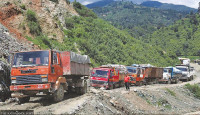Columns
Helping premature babies survive
Delivering a baby at a health centre adds the survival rate of women at risk of premature birth.
Ifeanyi M Nsofor
Preterm birth complications are the leading cause of death globally for children under five. Of the 15 million babies born before the 37th week of pregnancy every year, approximately one million will die. But new research conducted at secondary and tertiary health facilities in Bangladesh, India, Kenya, Nigeria, and Pakistan offers hope for increased survival rates.
These countries have some of the world’s highest numbers of preterm births. But a randomised clinical trial—known as Antenatal CorTicosteroids for Improving Outcomes in preterm Newborns (WHO ACTION-I)—proved that administering the steroid dexamethasone to pregnant women at risk of preterm birth in low-resource settings can boost their babies’ chance of survival, without increasing the incidence of bacterial infection in mothers. For every 25 pregnant women treated with the steroid, one premature baby’s life was saved.
As a young medical doctor undergoing training at a teaching hospital in Nigeria, I carried out blood transfusions in premature infants with jaundice. It is a tedious process that can lead to infections in newborns. The possibility of sparing mothers and their babies from such life-threatening procedures is one reason to consider the WHO ACTION-I trial a lifesaver.
But as important as the trial’s results are, this treatment for at-risk mothers cannot save every premature baby. There are at least four other ways to address some of the risk factors for premature births, while increasing child survival.
First, every pregnant woman should attend antenatal classes provided by skilled health workers. These classes are great platforms for giving women and their partners the right information for a safe pregnancy and screening for risk factors like hypertension and diabetes. Pregnant women could also undergo an ultrasound to check for multiple pregnancies and cervical weakness. If either is found, the pregnancy can be designated as ‘high risk’ and managed conservatively, usually by an obstetrician.
In Nigeria, two-thirds of pregnant women already attend some form of antenatal clinic. While Covid-19 has limited the frequency of antenatal clinic visits, they are sometimes offered online or through community outreach by health workers, so that pregnant women do not have to travel long distances. One of Nigeria’s foremost midwives, Tolu Adeleke, is pioneering online childbirth preparation classes for pregnant women and their partners.
Second, all women should deliver in health facilities under the supervision of skilled health workers. In many parts of the world, this is not the case. Studies show that 59 percent of childbirths in Nigeria take place at home, 35 percent of childbirths in Bangladesh are handled by traditional birth attendants, and 53 percent of deliveries in Kenya take place outside health facilities. Delivering in a health facility increases newborn survival rates, especially for women at risk of premature birth. Policymakers should deploy community health workers to provide information on the risks of home-based deliveries and accompany pregnant women to these facilities.
While such a strategy cannot address every reason why some women deliver at home—such as difficulty in reaching a health facility—it can help overcome the simple lack of knowledge about the benefits. In 2016, EpiAFRIC evaluated the SURE-P Maternal and Child Health Project, one of Nigeria’s top nationwide maternal-health interventions. A major finding was that after the project’s introduction, 32.1 percent more pregnant women gave birth at health facilities. The increase also led to more newborns being vaccinated against polio, hepatitis B, and tuberculosis.
Third, neonatal services that increase the survival rate of premature newborns must be improved. One example is kangaroo mother care, which helps to keep newborns warm. Premature newborns can suffer from hypothermia, and this type of care means they are carried (usually by the mother), with skin-to-skin contact providing warmth. In situations where the mother is incapacitated, her partner can step in. Another intervention that can increase newborn survival rates is access to alternative sources of breast milk. It is more challenging to begin breastfeeding a premature baby immediately after birth, and breast milk banks can provide screened and pasteurised supplies. Research in Ethiopia shows that mothers are more likely to accept donated breast milk if they are well informed about it.
Finally, all girls should be enrolled in school. When a mother is educated, she is more likely to attend antenatal clinics, deliver in health facilities, and practice other healthy behaviours. But more than 130 million girls are out of school globally, and Covid-19 lockdowns are likely to increase this number. The link between education and healthy behaviours underscores the impact of external social conditions on health outcomes. Health planners, programme managers, governments, the private sector, and donors must bear these conditions in mind when planning interventions.
The WHO ACTION-I trial is an important step toward increasing premature babies’ survival rate. But addressing the other risk factors is also necessary to help ensure that every mother, including those in low-resource settings, takes home a healthy newborn.
—Project Syndicate




 21.12°C Kathmandu
21.12°C Kathmandu















